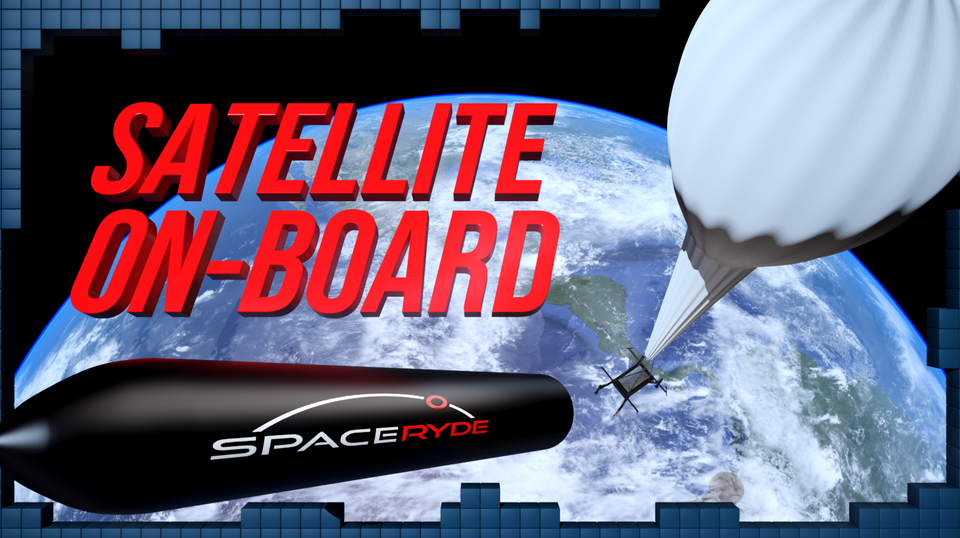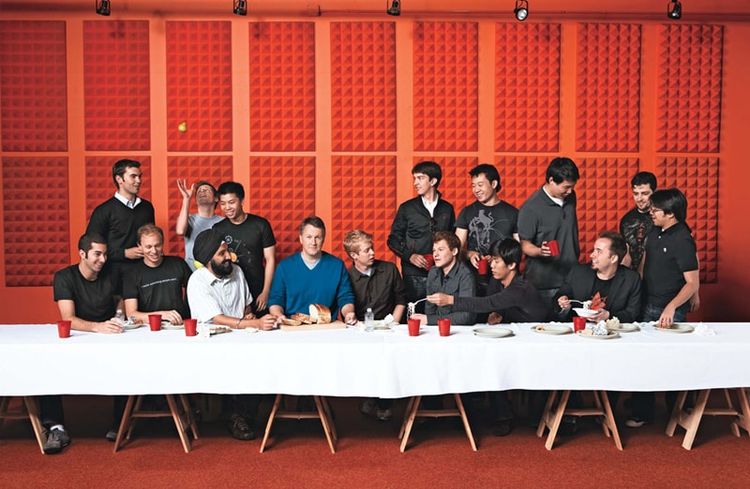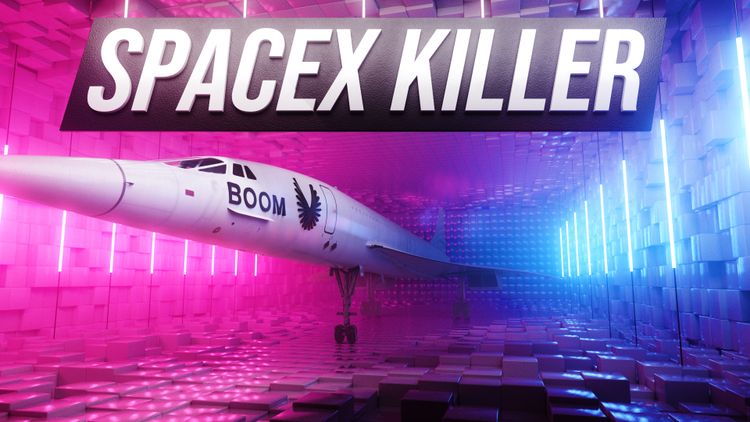SpaceRyde’s Mission To Create The Cheapest Satellite Launch Ever

If you think rocket science sounds difficult. Just wait until I tell you about this company, SpaceRyde. Instead of just launching rockets from the ground, they use balloons to carry rockets into the upper atmosphere before launching them. And surprisingly, it actually works!
At the center of the project is Sohrab Haghighat, the co-founder and CEO of SpaceRyde.
He’s a super talented engineer based in Canada, and he’s been building this company for the past five years.
Recently, we’ve seen a bit of an arms race to build bigger and bigger rockets. Starship usually gets all the attention, and for good reason. It can deliver a payload of a hundred metric tons to low earth orbit. SpaceRyde, on the other hand, can only deliver about a hundred kilos. That’s a thousand times less. But there’s actually a good reason for this approach. SpaceRyde’s goal is to make it easy for small satellites and payloads to reach space.
See, the space industry is growing so quickly now that there are needs at both ends of the payload spectrum. Starship and bigger rockets will obviously be incredibly important for huge payloads, but the high price can lock out smaller projects. Ridesharing on SpaceX rockets will work for some companies, but you’ll still need to deal with narrow launch schedules. If SpaceX is building a massive eighteen-wheeler, SpaceRyde is building a taxi service. It’s highly customizable and incredibly affordable. So let’s dig into how this all works.
SpaceRyde combines three main technologies to deliver payloads to low earth orbit. The first is the balloon, and this is by far the easiest part.
But before we talk about how the balloon works, we need to answer the obvious question of why you would even want to use a balloon in the first place.
Well, even though we don’t notice it when we’re just walking around. The atmosphere is pretty thick down here on Earth. All the air creates an incredible amount of drag on a rocket while it’s taking off. To counteract this drag, you just need more power, which means a bigger rocket. That, of course, means even more drag. This isn’t a problem for big rockets with big payloads, but if you're trying to deliver smaller payloads, you’ll wind up wasting lots of energy just plowing through the first layer of Earth’s atmosphere. To get around this problem, SpaceRyde uses balloons to reach the outside edge of the atmosphere.
There’s another benefit, though. During every rocket launch, at some point, you’ll hear the ground crew say, “we’ve reached MaxQ.” What that means is that the rocket has just reached the air pressure limits due to the atmosphere, and it needs to throttle back. When you launch a balloon 30 kilometers above the ground, MaxQ isn’t an issue, so you can design a completely different rocket. Sohrab and his team have done just that.
The History Of Hot Air Balloons And Space
Now, I don’t know anyone who would watch a balloon launch over a rocket launch, but they’re a significant part of modern science. NASA alone launches a new mission every month through their Scientific Balloon Program. And balloons are so simple to make that even high-school students can launch stuff into space using them.
Balloons are incredibly reliable at this point, but more importantly, they are incredibly cheap. The balloons SpaceRyde uses are made out of simple plastic materials, not unlike a shopping bag. And they fill it with hydrogen gas, which provides plenty of lift capacity and is extremely affordable.
If you’re ever looking at prices of anything in the space industry, you’ll be shocked to find anything selling for less than a million dollars. Even small parts on big rockets can be extremely expensive, and those costs get passed through directly to launch costs. This is why, even though the cost of delivering payloads to space is falling significantly on a per kilo basis, individual launches are still millions of dollars.
In fact, the cheapest rocket on a per-launch basis right now is provided by Astra, and it’s still around $3 million dollars. But SpaceRyde will offer launches for one-third that cost and has plans to push the price below a million dollars per launch soon. This could be disrupting at scale, and it’s impressive for such a small company. After all, Astra has raised hundreds of millions of dollars and is a public company. SpaceRyde has raised less than $5 million so far.
Leveraging existing and reliable technology is key to so many startup success stories, but the only reason balloons are so widely accepted in the aerospace industry is because they’ve been in use for over a hundred years now.
All the way back in 1912, an Austrian physicist named Victor Hess used a hot air balloon to measure radiation levels in the atmosphere. At the time, people believed that radiation came from the earth, so the higher you went, the lower the radiation would be, but his measurements showed that the radiation levels actually increased at high altitudes, suggesting that the radiation was coming from space. He had essentially discovered cosmic rays, and he won the Nobel Prize in Physics for his work.
Flash forward to 1949, and balloons again played a critical role in atmospheric research. A group of American naval scientists attached a rocket to a balloon and launched it off of the U.S.S Norton Sound. They called this rocket balloon a “rockoon,” and even though it did successfully launch the rocket, the fact that they couldn’t steer the contraption really limited its usefulness.
But SpaceRyde has solved this problem with their second key piece of technology: the rocket carrier.
No one is going to pay SpaceRyde to launch their satellite into orbit if they can’t guarantee where it will wind up orbiting. A big part of the SpaceRyde value proposition is that small satellite companies will be able to choose when to launch and also the exact orbit they want their satellite to be in. That type of customizability is largely unattainable via larger launch companies like SpaceX, unless, of course, you’re willing to fork over the millions of dollars it costs to cover the entire launch.
The SpaceRyde rocket carrier attaches the rocket to the balloon and, more importantly, makes sure that the rocket is pointing in the right direction when it launches. The carrier itself looks kind of like a quadrotor drone, but there are some really important calculations going on to make subtle corrections and make sure the rocket is aligned properly at launch.
Air launches have been tried before, but they’ve never really made much economic sense. The most well-known air-launched rocket is the Northrop Grumman Pegasus, which has been in operation since 1990. Even though Pegasus has had a solid track record over the last thirty years, it still costs $40 million per launch and has a host of other problems.
Back in 2012, Elon Musk addressed the Pegasus vehicle directly:
“When you drop the rocket, you have a slight problem because you're not going in the right direction. If you see what Orbital Sciences did with Pegasus, they had the delta wing to do the turning maneuver. And then you added this wing which is added mass. And the net is that it’s not great. They started out with the Pegasus air-launch vehicle and subsequently, they haven’t done any air-launch vehicles.” - Elon Musk
Simply put: That delta wing on top of the Pegasus rocket is inefficient. But SpaceRyde doesn’t need one of those on their rocket because the rocket carrier can position the rocket automatically before it launches.
Why Now? The Reason For SpaceRyde’s Success
It’s an interesting situation, where advances in software lead to simpler hardware solutions. Similar to how self-driving cars have been able to move away from complicated lidar systems and just use normal cameras because of advances in machine learning. This is always a great place to be for a startup. Software is getting better at a much faster rate than hardware, so anytime you can leverage the cutting edge of software development, you’ll have an advantage.
And Sohrab knows this intimately. Before he founded SpaceRyde, he actually worked on self-driving cars at Cruise Automation. While there, he worked on Planning and Controls, which has a remarkable amount of overlap with the work he’s doing now at SpaceRyde.
Every autonomous vehicle has to do two things. First, it had to perceive the world, which basically means stitching together all the camera and sensor data into a 3d representation – kind of like a video game. Then, the system has to use that data to operate the car safely, which means planning out a safe path and then sending inputs to the steering wheel and gas pedal accordingly.
Sohrab worked on that second part at Cruise, and it’s a perfect fit for SpaceRyde. The perception problem is a lot simpler in a balloon since there are no pedestrians to deal with up in the sky. But controlling the rocket carrier is remarkably similar to controlling a car.
When the team goes to launch a balloon, they know the general trajectory and can plan out a basic course of action. But once everything lifts off, the autonomous systems have to take over. Being able to reliably steer the carrier without a pilot is really tricky, but doing this with software means it’s ultimately more reliable and more affordable.
Once the balloon is up there, and the rocket carrier is in the right position, what happens?
Well, they have to launch the rocket. But SpaceRyde rockets are custom-made to take advantage of the high altitude.
“When you look at rockets they are often tall and sender. There is a reason. Because you are minimizing drag. There is no drag concern when you are launching at 30 kilometers of altitude. So your rocket can be short and chubby. And a fat rocket is actually a good rocket.” - Sohrab Haghighat
This “fat” rocket design is more than just funny though. It actually serves a very specific purpose. Although the design is unorthodox, these SpaceRyde “fat” rockets find the perfect balance between structural integrity, fuel efficiency, and payload capacity.
This is super critical because SpaceRyde is all about unlocking the small payload delivery market, which is actually growing incredibly quickly. Pretty much everyone knows about StarLink at this point, but global internet is far from the only useful application for small satellites. Increasingly, satellites are getting smaller and smaller, all while being more versatile and useful.
This can be hard to visualize because when most of us think about satellites we imagine the Hubble telescope or the international space station. You know, the type of space stuff that’s big enough to point a camera at. But satellites are getting small, like, really small.
Traditionally, a small satellite is defined as anything under one thousand kilograms. But SpaceRyde is only planning on carrying between 80 and 150 kilograms. That’s not a problem though because microsatellites or “CubeSats” typically weigh less than 100 kilograms, with some as light as just 10 kilos.
There are also “nanosatellites” now that weigh under 10 kilos, “picosatellites” that weigh less than one kilo, and people are even prototyping “Femto-satellites” that weigh less than 100 grams. At that point, it’s basically just a simple chip floating around up there, but as we’ve seen with smartphones, you can fit a lot on a single chip these days.
So, we have a few technology trends all accelerating and converging at the same time to make this a reality. Demand for satellites is increasing exponentially, satellites are getting smaller and smaller, and autonomous control software is getting better. All of these trends point to an easy win for SpaceRyde, right?
Well, not so fast.
Sohrab has been working on this for the past five years and I could tell from my conversation with him that it hasn’t all been easy. First off, he’s doing all of this in Canada, which hasn’t had an active launch program in the country for decades. Canada does have astronauts, but they partner with the United States and European Space Agency for actual launch capabilities.
Fortunately, Sohrab has an amazing partner in his wife and co-founder Saharnaz. She has an MBA and serves as SpaceRyde’s chief operating officer, so when it was time to work with the Canadian government to get regulatory approval, she stepped up and got it done in record time.
Often the best founding teams have different but complementary skill sets. After all, it doesn’t matter how well designed your rocket is if no one will let you launch it.
But there’s one more key takeaway that I love from this story, and it’s about determination.
Sohrab probably could have coasted as an engineer in Silicon Valley for his entire career. Cruise was a massive success and he was there early, but he wanted to pursue something bigger.
He clearly cares deeply about space and what it can unlock for humanity broadly. Lots of people aspire to work in amazing industries and have an impact when they're young, but then they get caught on a particular treadmill and lose sight of their original goal. Sohrab took a large risk by switching industries after leaving Cruise. He probably could have worked at any self-driving company, but he chose to pursue something bigger.
And he didn’t just risk a few resume bullet points. He actually took out a second mortgage just to pay for SpaceRyde’s rocket testing facility. No one would rent SafeRyde land to test rockets, so he just did it himself.
When you’re working at a big company, enjoying free lunches, it can be hard to take a leap of faith and go build something in a garage. But I’m certain that when Sohrab looks back on his time building rockets in his garage, he won’t regret one minute of it.
If you enjoyed this blog post, make sure to check out similar articles on the site. If you enjoy discussing tech, space, entrepreneurship, and much more, you should head over to our Discord Community.
This blog post is also available as a video:




